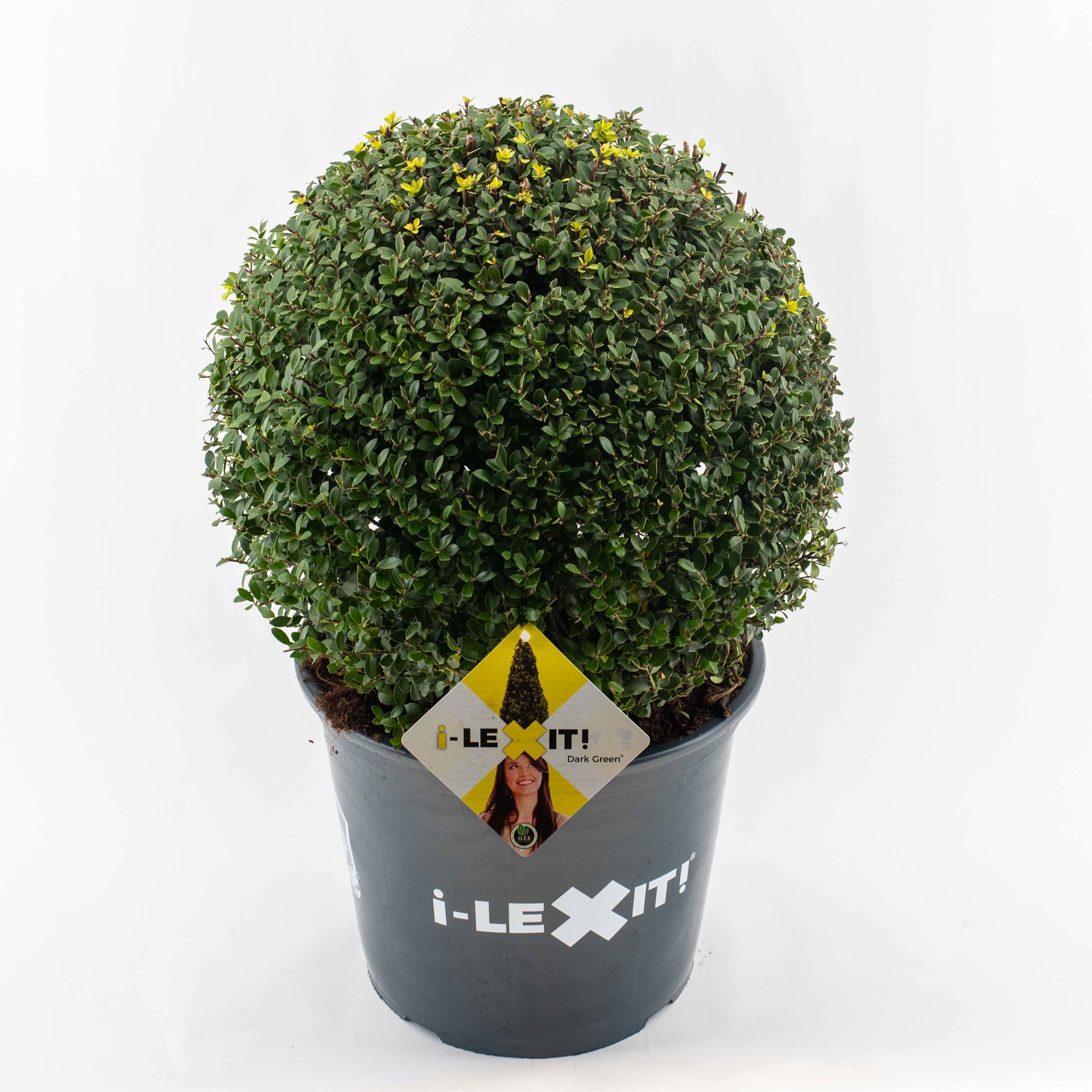Ilex crenata 'Icoprins11' (Dark Green) - pot 15L - spherical shape - ø40+ cm
Japanse hulst
Product information "Ilex crenata 'Icoprins11' (Dark Green) - pot 15L - spherical shape - ø40+ cm"
Boxwood-like Japanese holly, boxwood-like Ilex.
Distribution:
This species is found mainly in Japan, in Hokkaido, Honshu, Shikoku and Kyushu; in moist places in the lowlands and mountains. The species was selected from young seedlings in 2000 by the tree nursery Oprins, Belgium and was protected by plant breeders' rights in 2007.
Growth and characteristics:
Evergreen, slender upright to very dense foliage, less excellent than other growing holly species, always taller than wide; grows irregularly with age, then with drooping, broadly outgrown to slightly overhanging branches (if not pruned). Because of its size and attainable height also suitable for more than man-sized hedges. Final height and appearance unknown, presumably like the other species. Very high regeneration capacity. The bark of the new shoot is brownish, darkening with age. Firm and tough wood.
Size and height:
When fully grown probably up to 3.5 m high, on favourable sites also higher. Young plants do not grow hesitantly, from the first year of growth they average up to 25 cm per year. In a container with a very good supply of water and nutrients, even more. After several years of standing the plant also grows more annually, over the years 15 cm in height, 10 cm in width. six-year-old plants, measured from the year in which the then 15/20 cm high holly was planted, are about 125 to 150 cm high. Influence of pruning here relatively unimportant, since very strong regenerating.
Leaves:
Evergreen, alternate, oval to elliptical, usually up to 2 cm long, if grown in greenhouses under protected conditions. In transplanted specimens, the leaves remain visibly smaller, at least after transplanting. Later on in the final location the leaf size is as indicated. Leaf color: dark green, only slightly shiny. Short, brownish petiole, like the shoots.
Blossoms:
The species is dioecious, the Dark Green is a female plant. The blossoms are very small and inconspicuous, dull white, they bloom in May-June. Feeding ground for bees, for the garden owner, however, the blossoms are not interesting.
Fruits:
Stone fruits; black, up to 6 mm in size, long lasting, popular food for birds, therefore natural dispersal; poisonous, consumption causes diarrhea and vomiting.
Roots:
Fine, densely branched roots, many fine roots in the upper soil layer. root growth at first hesitant, antagonistic until shoots shoot.
Stand:
Likes a humid climate; in full sun or semi shade, can also be placed in light shade under trees; protect from winter sun and drafts. Sensitive to summer drought, dry air and soil. In dry air infestation with red spiders possible.
Soil:
Humic, nutritious, moist but permeable soil, prefers sandy, humus-rich gravel or acidic mineral soil; slightly acidic to neutral; loamy-clayey, dense sites or sites with water logged are not suitable at all, if pH is too high chlorosis will occur. Sensitive to summer drought;
Properties:
Hardy; can tolerate low temperatures without problems when planted and rooted in; likes high humidity; can't stand heat and long droughts; likes shade a lot; not sensitive to root pressure; can be pruned easily; suitable for the city.
Uses:
The species is used in Japan as a standard plant in Japanese gardens, where pruning is very important. The species is also suitable for flat bulb, cone, or pyramid shapes; also for green art objects, which by removing entire branches and shortening the remaining twigs make the plants look older. Because the plant is easily pruned, it is ideal as a hedge, but takes several years to grow to sight height. Also very suitable as a border and hedge for the front yard.
Recommended garden use:
Hedges (man-sized), borders, bowls, troughs, window boxes, on the patio, pruned bulbs and cones, alternative to other evergreens.
Growth: densely vegetated ascendingLeaf
: evergreen, ovalFlowers
: May to June, dioecious, creamy whiteFruits
: from September to winter; black; round; poisonousPlace of stand
: fresh to moist, permeable, acidic, humus-rich; in full sun to partial shade
Product specifications
| Application / use plant: | Tree level/tree wreath, Hedge plant |
|---|---|
| Average number per m²: | 5 |
| Average number per running meter: | 5 |
| Bloom Month: | May |
| Bloom color: | White |
| Branches / bark: | Unknown - n/a |
| Flower color - details: | Creamy white, not very striking |
| Frost hardiness - details: | Good (-23 to -18°c), usda zone 6 |
| Frost resistance: | Very good winter hardy |
| Fruit: | Berry-shaped, Black |
| Fruit - details: | Black, small |
| Full grown plant height: | 150-200 cm |
| Growth habit : | Rising |
| Growth habit - details: | Wide rising, branching from the ground |
| Humidity/Soil: | Moist soil |
| Latin plant family: | Aquifoliaceae |
| Leaf / Foliage: | Green, Evergreen |
| Leaf / foliage - details: | Evergreen, dark green, when sprouting cleargreen |
| Location: | Shadow |
| Location - details: | Sun or shade |
| Minimum growing height (in cm): | 150 |
| Plant characteristic: | Toxic, Sea wind proof |
| Plant family: | Holly family |
| Planting distance: | 4-5 pieces per running meter (20-25 cm apart) |
| Pruning period: | May, July, September |
| Synonym / Trade name: | Ilex crenata Dark Green |
| Winter foliage: | Leaf-holding |
| maximal growth height (in cm): | 200 |
| type of crop: | Shrub |
| type of soil: | Dry soil, Calcareous soil, Clay soil (calcareous), Normal soil, Peaty soil (acidic), Sand soil |
| type of soil / ground - details: | Any good garden soil |
Pictures of this plant
Reviews
Login













